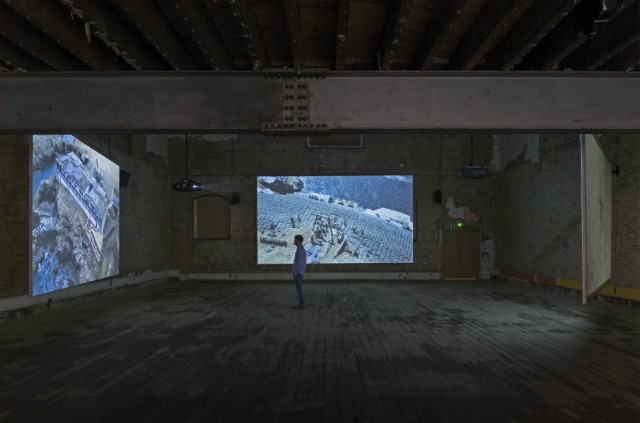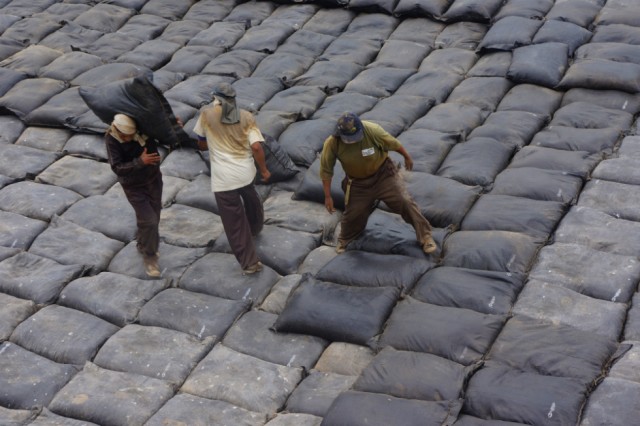“Disorientating films… Desperate inhumanity”: Dinh Q. Lê’s The Colony — Reviewed
Jacob Charles Wilson analyses Dinh Q. Lê’s latest video installation: a post-colonial battleground buried deep (literally and metaphorically) in thousands of years of shit…
It seems unfair that the word colony should be shared between the natural and human worlds. Groupings of animals can hardly be compared to human colonies; exploitative political arrangements with horrific histories that to this day have been deliberately obscured; at best, barely acknowledged. Vietnamese-American artist Dinh Q. Lê’s latest three-channel video installation, The Colony, hovers somewhere above the lines of inhuman and human stories, revealing that, at the base of it, both human and animal territories are quite similar. Both are built on massive stratigraphies of waste and death, composed of a lot of people and a lot of birds — and deep in thousands of years of shit.
The Colony, co-commissioned by Artangel and Ikon Gallery, Birmingham, is now installed at 133 Rye Lane in Peckham; formerly a butcher’s shop, and before that The Electric Theatre, one of the first cinemas in London. The day I visit is in the middle of a heatwave. It’s a crumbling building, barely renovated, and as I climb the stairs to the old theatre I begin to hear a cacophony of drills and feel my breath labour. It comes close to, but never reaches, the experience of the three islands that Lê subjects to the roving lenses of his drone cameras.
The Chincha Islands, 21 kilometres off the coast of Southern Peru, were once the home of the Chincha people. Over the past 200 years, the islands have been contested, between Spain, Peru, and Chile. Today, these desolate rocks are not for humans; there are no trees, there is scant life, except for hundreds of thousands of birds. But over that time, they have become home, in the loosest sense of the term, to impoverished Peruvian peasants and indentured migrant Chinese labourers, who harvested by hand their only natural commodity: guano, a surprisingly valuable chemical resource.
Guano provided the nitrogen, phosphates, and potassium necessary for manufacturing fertilisers and explosives. It was so vital to industrial expansion that the US Guano Island Act of 1856 mandated citizens to claim guano islands for the Federal Government, and authorised the use of military force to defend these new colonies. At the height of the Great Guano Rush, up to 10,000 labourers were drawn or pushed to the islands. Now they lie largely exhausted; demand having far exceeded the ability of the last remaining seasonal workers to meet it. Instead, synthetic chemical manufacturing processes have taken over.

For a series of rocks poking out of the sea, the islands are achingly dry — deserts of dust and bleached bones that gleam under the relentless sun. Shaped first by geology, then birds, and more recently by humans, the islands, through the logic of quarrying, have become a striated architecture of steps, banks, and slides. Lê’s cameras survey the landscapes as the dessicated guano is dug by hand, bagged, and stockpiled on vast platforms, themselves made from older bags of guano. This architecture of shit is punctuated by the occasional crumbling building, built in a modernism of nautical curves and reinforced concrete that lends an unsettlingly close and comforting sense of the present day to the islands. Again, every inch of these last remnants of human architecture is covered in rings of guano from the ground-nesting birds. It’s evident that humans shouldn’t be there.
The desperate inhumanity of the islands is emphasised in Lê’s removal of human perspectives through the use of a pair of drone-cameras, with almost as much time dedicated to filming the drone-cameras themselves as the people. These spindly black machines move with a distinct purpose across the landscapes; investigating and mapping the hybrid human-animal terrain, but in a fashion unlike people or birds, slow and methodical. No explanation is given for their movements; the film, chopping between locations, doesn’t describe one single journey. The narrative of human occupation is that seen by a machine. Piloted with skill, these drones move into the old dorms of the workers.
Inauthenticity and shifting grounds of actual and remembered histories has been explored by Lê before. Lê’s three-channel film The Farmers & the Helicopters (2006) looked at the US and Vietnamese cultural memories of the Vietnam war, focusing on the association of the war with helicopters. Lê himself recalls that it never occurred to him at the time to regard the helicopter as a symbol of the war; this happened only once he moved to America and watched Hollywood films. The Colony is the first of his video works to depart from the topic of Vietnam, but continues Lê’s investigation and explication of post-colonial issues.
In one of the three films, there are two moments in which Lê introduces the ghosts of the human-colonial past through animated silhouettes: their conical hats and qu haircuts marking them as the Chinese-bonded labourers who once worked there. Yet these animated moments of departure from Lê’s quasi-documentary art-film seem a little out of place aesthetically, and also in terms of the tone of the work, as it seeks to address the issue of bonded labour.

This theme is somewhat underplayed and unresolved in the film, and yet is so pertinent, since Britain is culpable in this history. In the publication that accompanies the installation, Dr Frank Uekötter of the University of Birmingham notes that Britain bought more guano than any other country, and was most significant in the business that grew around the industry. Whilst the publication features Dr Uekötter’s own expansive essay (online version sadly not available), alongside an interview between Lê and Zoe Butt (curator of Ikon Gallery), it would benefit from an additional piece focussing on the bonded labour.
The attempts to draw links between the formerly contentious status of the Chincha Islands and current issues was explored in the original installation at Ikon Gallery; which alongside The Colony featured video footage of Chinese ships and Vietnamese fishing boats clashing over territorial rights to fishing in the south China sea. This attempt was criticised in previous exhibitions, and it seems the curators have taken note.
In Peckham, the focus has been kept on the islands themselves, with the accompanying material presenting a series of vintage vitrines holding news clippings from The Daily Graphic, and photographs of the islands by the 19th century US photographer Henry Dewitt Moulton. I found that this small exhibit of archive material gave respite from the disorientating films; the three looping channels range from eight minutes to 11 and a half, which produces an effect of overlapping videos, new juxtapositions between subjects. In the dimly lit and subtle scored room, it was difficult to tell how long I’d spent there. A series of events or an overlapping.
Jacob Charles Wilson
See Dinh Q. Lê’s The Colony at 133 Rye Lane (entrance through Bussey Alley), Peckham , London, from 25 August-9 October 2016. Open Wednesday-Sunday, 11am-7pm — FREE
Commissioned by Artangel, Ikon, Birmingham, Han Nefkens H+F Collection, Proyecto Amil, Lima, with additional support from, Catherine Petitgas, Private Collection, New York, Shoshana Wayne Gallery. Produced by Artangel and TANQ Studios, this project was supported by Arts Council England, Artangel International Circle, Special Angels, Guardian Angels and The Company of Angels.
Photographs: Marcus J Leith, courtesy Artangel.





